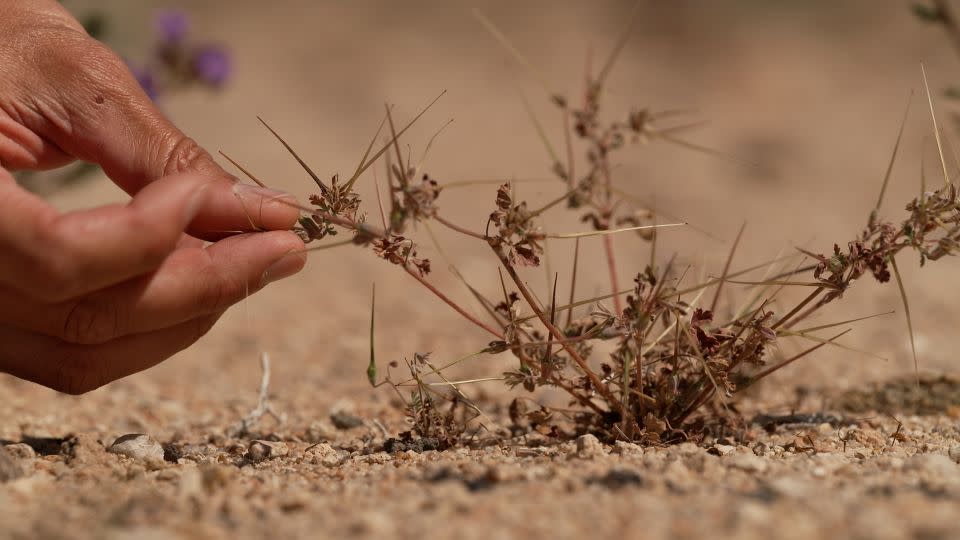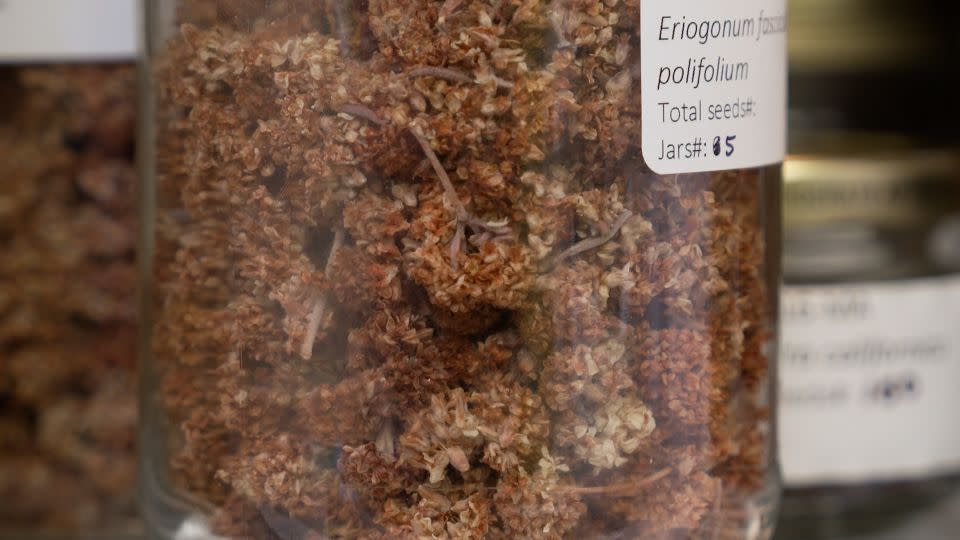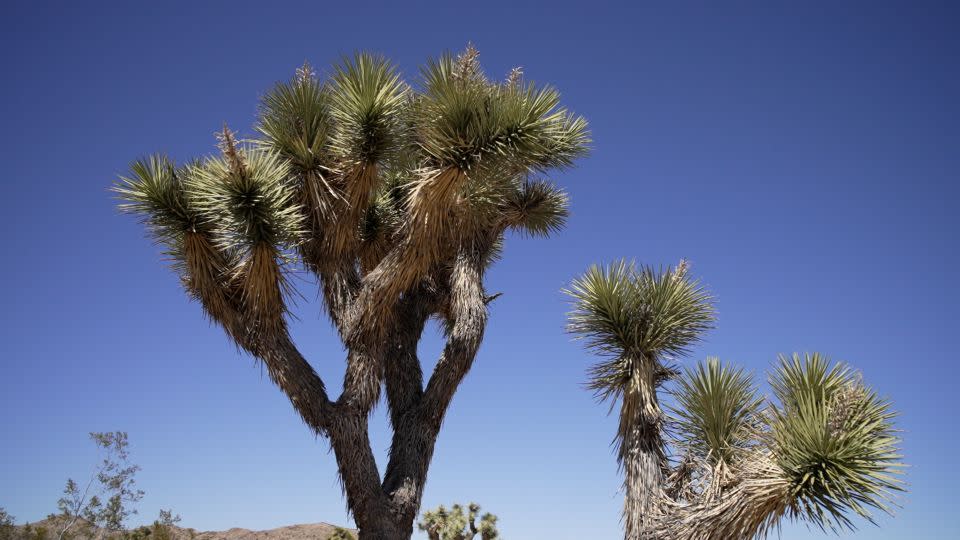‘Seeds are life’: How a seed bank in the Mojave Desert is preserving an ancient ecosystem under threat
Editor’s Note: Call to Earth is a CNN editorial series committed to reporting on the environmental challenges facing our planet, together with the solutions. Rolex’s Perpetual Planet initiative has partnered with CNN to drive awareness and education around key sustainability issues and to inspire positive action.
Inside a Mojave aster flower, a tiny bee is fast asleep. At night, the pale lavender petals close, providing a safe resting place. In the morning, as birdsong rings out across the desert, the flower opens, revealing its tenant.
Here in southern California, in the middle of the Mojave Desert’s vast and arid landscape, it’s just one of many natural treasures hidden from view.
In long sleeves, pants, and wide-brimmed hats to guard against a harsh sun in a cloudless blue sky, a team of four led by Madena Asbell crouches in the dirt, looking for another treasure.
They are searching for a plant called erodium texanum, (common names Texas stork’s bill or heronbill), a type of herb native to California. More specifically, they are looking for its seeds.
“There’s so much life here,” Asbell says, “but it’s easy to not realize that when you’re in the desert.”
Asbell is the director of plant conservation for the Mojave Desert Land Trust (MDLT), a non-profit land conservancy that works to preserve and protect the Mojave and Colorado desert landscapes of California.
A quarter of the state is desert, home to roughly 2,400 plant species, according to MDLT. Eight years ago, Asbell had an idea. What if there was a way to preserve the ecosystem, centered around the seeds that facilitate all the life here? The result was the Mojave Desert Land Trust seed bank.
“The goal is to preserve this amazing genetic diversity that we have and make it available for restoration or reintroduction of species, should there be a disaster that wipes out a population,” Asbell says. “Plants are the foundation of most ecosystems, so when we protect these plants, we’re protecting everything that depends on them, like desert tortoise, burrowing owls and pollinators.”

Five million seeds, and counting
In an ever-changing climate, the seed bank was just the type of “proactive” idea the organization was looking for, says Kelly Herbinson, executive director of MDLT.
“As a land trust, we’re realizing that just protecting land or buying land to protect it wasn’t going to be enough – that we had to take extra steps to really invest in that land,” Herbinson says.
In 2016, Mojave Desert Land Trust officially launched the seed bank project, which has since been described as a “Noah’s Ark” for southern California.
Three white refrigerators at MDLT headquarters in Joshua Tree, California, house the collection. There are over 5 million seeds from nearly 250 species and counting, according to the land trust.
Seeds come in from the field teams and undergo a “cut test” to determine viability – confirming the seed pods are full, and that there hasn’t been too much damage from insects or mold, making the seeds worth saving.
They then go into paper bags on racks to dry out, before going into jars in the refrigerators for long-term storage.
All types of jar shapes and sizes pack the shelves inside, from small, donated Gerber baby food jars to larger pickle jars – each adorned with white labels including seed name, number of jars in the collection, and number of seeds.
Much like the desert itself, the seed bank contains all kinds of variation. Some seeds are light and wispy; some are skinny or round. Others are denser, like peppercorn, while another resembles pumpkin seed. There are shades of brown, red and olive green.
Asbell says that work at the seed bank includes scouting, collecting, processing and database management.
Last year, MDLT received a $3.2 million grant from the state of California’s Wildlife Conservation Board to help expand the project.

“We’ve already been able to provide seed to researchers who are studying the effects of climate change on specific species that we have in our seed bank,” Asbell adds. “And knowing not only what you’ve collected, but where it has come from in a really specific way is very important for restoration.
“You can’t just throw any seeds on the ground … You need to know where that seed has come from, what population, what elevation, and make sure that it’s the right seed for the right place. Those are things that we are able to do through the work that we’re doing.”
Helping the future of the Joshua tree
There is an increased urgency to that work. California has felt the impacts of climate change, from more frequent and intense wildfires, says Herbinson, to an influx of invasive grasses that are not only choking parts of the desert landscape but acting as fuel for the wildfires.
“Climate change brings drought and more prolonged drought, which really stresses desert ecosystems, even though they are adapted for aridity,” Asbell says.
“We’re facing really unprecedented challenges that threaten our existence and to be able to preserve the genetic diversity of the planet for a future time when it may be needed is really amazing – it’s really critical work,” she adds.
The desert itself is “the kind of place where you can pass it by and look at it and think there’s nothing there,” Herbinson says. “But in reality, it’s incredibly biodiverse and full of so much life. It’s just secret and hidden in ways that aren’t obvious.”
That means it’s not as well protected as other ecosystems, she adds, such as rainforests or oceans – which come with more colorful trees and wildlife.
Yet the Mojave Desert boasts an iconic tree of its own: the Joshua tree.
“We have this incredible endemic species that’s very charismatic and has this very kind of unusual structure to it,” Asbell says. “It’s widespread across the landscape, but also very threatened and so we’re very concerned about the future of the Joshua tree and working really hard to protect it.”
A type of yucca, the twisted, Dr. Seuss-like tree, which lends its name to a national park in the same area is “not likely to persist through our changing climate,” Herbinson agrees, “because their seeds are dispersed largely by rodents.”
To survive, there will likely come a time when the trees will need to migrate to a more “suitable habitat,” she adds – ideally cooler and at higher elevation. But that distance is beyond the range of the rodents, who only disperse seeds up to 100 feet from the tree. That’s where the seed bank could help.
“It means we can help the Joshua tree migrate potentially faster than it would naturally, and have that species survive the changing climate well into the future in a way that it wouldn’t if we weren’t doing that work,” Herbinson says.

Roughly 70,000 Joshua tree seeds are currently preserved in the seed bank, some of which could be planted in cooler locations, if needed. The key, according to Asbell, is balance: taking just the right amount to sustain a restoration project in the event of an emergency, but not so much as to disrupt the natural ecosystem.
“This is an ancient landscape, she says. “It’s pretty profound to think about how long-lived a lot of these organisms are, and how much history they’ve experienced.”
“Seeds are life,” Asbell adds, “and I don’t know that anything brings me as much pleasure as growing a seed. … It’s life affirming. And in the world we live in today, you have to really hold onto that and keep that close.”
CNN’s Adeline Chen contributed reporting.
For more CNN news and newsletters create an account at CNN.com

